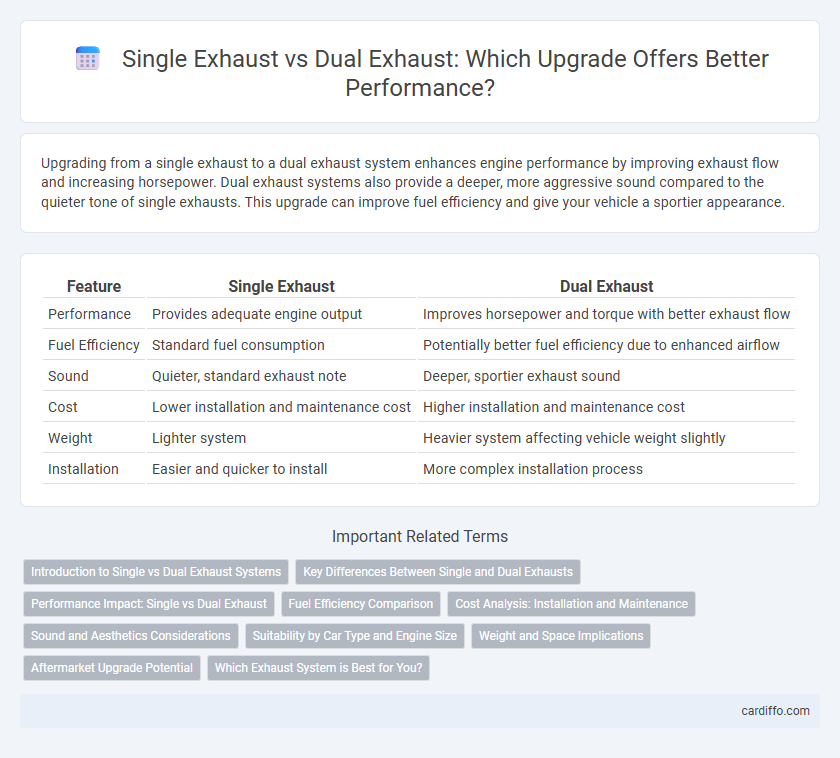Upgrading from a single exhaust to a dual exhaust system enhances engine performance by improving exhaust flow and increasing horsepower. Dual exhaust systems also provide a deeper, more aggressive sound compared to the quieter tone of single exhausts. This upgrade can improve fuel efficiency and give your vehicle a sportier appearance.
Table of Comparison
| Feature | Single Exhaust | Dual Exhaust |
|---|---|---|
| Performance | Provides adequate engine output | Improves horsepower and torque with better exhaust flow |
| Fuel Efficiency | Standard fuel consumption | Potentially better fuel efficiency due to enhanced airflow |
| Sound | Quieter, standard exhaust note | Deeper, sportier exhaust sound |
| Cost | Lower installation and maintenance cost | Higher installation and maintenance cost |
| Weight | Lighter system | Heavier system affecting vehicle weight slightly |
| Installation | Easier and quicker to install | More complex installation process |
Introduction to Single vs Dual Exhaust Systems
Single exhaust systems feature a single pipe to expel exhaust gases, providing a simpler design that often results in lower installation costs and reduced vehicle weight. Dual exhaust systems use two separate pipes to improve exhaust flow, enhancing engine performance and increasing horsepower by reducing back pressure. Understanding the balance between cost efficiency and performance gain is essential when choosing between single vs dual exhaust setups.
Key Differences Between Single and Dual Exhausts
Single exhaust systems feature one exhaust pipe that channels gases from the engine, providing a simpler design and generally lower cost but less efficient gas flow. Dual exhausts utilize two separate exhaust pipes, improving engine performance by reducing back pressure, enhancing horsepower, and offering a sportier sound profile. Key differences include improved exhaust flow and horsepower gains with dual systems, while single exhausts prioritize cost-effectiveness and easier maintenance.
Performance Impact: Single vs Dual Exhaust
Dual exhaust systems improve engine performance by allowing exhaust gases to exit more efficiently, reducing back pressure and increasing horsepower and torque. Single exhausts tend to restrict exhaust flow, which can limit engine breathing and reduce overall power output. Vehicles equipped with dual exhausts often experience better acceleration, enhanced fuel efficiency, and a more aggressive exhaust note compared to single exhaust configurations.
Fuel Efficiency Comparison
Single exhaust systems generally offer better fuel efficiency due to lower weight and reduced backpressure, allowing the engine to operate more efficiently. Dual exhaust systems can improve performance by enhancing exhaust flow but often increase fuel consumption because of added weight and complexity. Choosing between single and dual exhausts involves balancing fuel economy needs with desired power output.
Cost Analysis: Installation and Maintenance
Single exhaust systems generally cost less to install and maintain due to fewer components and simpler design compared to dual exhaust systems. Dual exhaust installation involves higher expenses for additional pipes, mufflers, and labor, which increases upfront costs and potential maintenance complexity. Over time, maintenance for single exhaust remains more affordable with fewer parts prone to wear or damage.
Sound and Aesthetics Considerations
Dual exhaust systems typically produce a deeper, more aggressive sound compared to single exhausts, enhancing the auditory appeal for performance enthusiasts. Visually, dual exhausts create a balanced and sportier rear appearance, often associated with high-performance vehicles, while single exhausts offer a simpler, more classic look. Sound tuning and muffler design further influence exhaust tones, making dual setups preferable for those seeking both aesthetic and acoustic upgrades.
Suitability by Car Type and Engine Size
Single exhaust systems typically suit smaller cars and engines up to 2.0 liters, offering efficient exhaust flow and cost-effectiveness for daily driving. Dual exhaust setups better fit larger vehicles with engines above 2.0 liters, improving exhaust gas expulsion and enhancing performance in trucks, sports cars, and SUVs. Engine size and vehicle type determine the optimal exhaust configuration for balancing power, fuel efficiency, and emissions compliance.
Weight and Space Implications
Single exhaust systems weigh less and occupy less space compared to dual exhaust setups, making them ideal for lightweight vehicle designs. Dual exhausts increase overall weight due to additional piping and components, potentially affecting fuel efficiency and handling. The larger spatial requirements of dual exhausts may limit engine bay modifications or aftermarket upgrades.
Aftermarket Upgrade Potential
Single exhaust systems offer a straightforward, cost-effective aftermarket upgrade path, improving performance and sound with fewer modifications needed. Dual exhaust setups provide greater potential for horsepower gains and enhanced engine breathing, appealing to enthusiasts seeking maximum performance enhancement. Aftermarket options for dual exhausts often include tunable components, such as high-flow catalytic converters and performance mufflers, enabling more precise customization.
Which Exhaust System is Best for You?
Single exhaust systems offer simplicity, lower cost, and lighter weight, making them ideal for everyday vehicles seeking improved fuel efficiency and basic performance upgrades. Dual exhaust systems enhance engine breathing, increase horsepower, and provide a more aggressive sound, best suited for high-performance cars or enthusiasts prioritizing power and aesthetics. Assess your driving style, vehicle type, and performance goals to determine whether the balance of efficiency or maximum output aligns better with your needs.
Single exhaust vs dual exhaust Infographic

 cardiffo.com
cardiffo.com